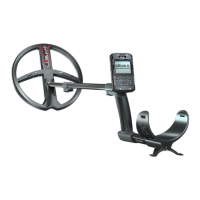14
Discrimination and target identication (T.ID)
Display T.ID (Target Identication)
Congure the main detection settings.
Press
MENU
.
Scroll through the menu with .
Exit with to return to the main menu.
MENU
ferrous items
Coke
Small
Gold jewellery
Ferrite
GROUND ZONE
Foil
Thin coins
Poor alloys
Bronze coins
€/$/£
Small silver coins
large silver and
copper coins
SENSITIVITY
DISCRI
EXPERT
MENU
9022
6.8
FREQ. SHIFT
T.ID G.ID
Adjust the Discrimination level from -6.4 to 99 using + and - .
Increase the discrimination to gradually reject targets with a lower conductivity
than the setting. Example :
• Adjust to 10 to reject items with a target ID lower than 10.
• Adjust to 40 to reject most small aluminum foil.
DEUS II displays deep targets more precisely through its multi-frequency process-
ing that removes a large proportion of the troublesome ground effects.
The metal target conductivity scale below from -6.4 to 99 will give you an idea of
the display and discrimination range :
I 95
I 5
To reject unwanted targets with a higher conductivity (aluminum tabs, lead, copper cartridges, etc.), you
will have to accept losing certain desirable metal targets. A more satisfactory alternative is to continue
using a low discrimination level (e.g. discrim. at 8) and use preferably:
• The visual target display for visual discrimination.
• Multi-tone mode for audio discrimination.
• The B.CAPS function (bottle caps) to reject the rusty ferrous caps effectively (Discri > Expert).
One of the advantages and special features of
is its programs, as they use different combina-
tions of simultaneous frequencies while adapting to multiple ground types (see Programs).
However, a few ferromagnetic targets will generate specic displays on certain programs. These targets
cannot be generalized due to their ferrous components, otherwise there will be a risk of falsifying the dis-
play of all the other targets. E.g. one or two euro coins (ferromagnetic ring + copper center) will display 75
in the Diving and Relic programs but 80 in all the other programs. Diving and Relic use fairly low detect-
ing frequencies from about 4 to 13 kHz, whereas the others include higher frequencies such as 40 kHz.
Brick,
Ceramic
OPTION MENU
FAST
G.B.
- 6.4 - 5 - 4 0 10 20 30 40 50 60 70 80 90 99
90
90
F
NF
G.ID
G.SET
GND
LV L
OPTION
MENU SOL
46

